 |
|
|
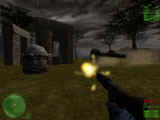 Judging from the reactions of gamers since its release, one thing is clear
about Heavy Gear II. It is the Uma Thurman of giant robot games. Either you love it
immoderately, or it leaves you lukewarm. I’ve got to admit I fall into the second
category—while aware of and even standing in admiration of its considerable charms,
Heavy Gear II, like Uma, is just not my type. I realize this is not likely to cause a
great deal of dismay to either Ms. Thurman or the folks at Activision, but I’m afraid
that’s the way it’s going to be for at least some other gamers, and is
therefore something you should be aware of before you plunk down 50 bucks for the game.
With that in mind, I’ve concocted a short quiz to determine whether or not you should
purchase Heavy Gear II. Judging from the reactions of gamers since its release, one thing is clear
about Heavy Gear II. It is the Uma Thurman of giant robot games. Either you love it
immoderately, or it leaves you lukewarm. I’ve got to admit I fall into the second
category—while aware of and even standing in admiration of its considerable charms,
Heavy Gear II, like Uma, is just not my type. I realize this is not likely to cause a
great deal of dismay to either Ms. Thurman or the folks at Activision, but I’m afraid
that’s the way it’s going to be for at least some other gamers, and is
therefore something you should be aware of before you plunk down 50 bucks for the game.
With that in mind, I’ve concocted a short quiz to determine whether or not you should
purchase Heavy Gear II.
A. Stomping around in a towering, sixty-ton fighting machine. 3. A game’s interface should be: 4. In any giant robot game, mechs should come equipped with: 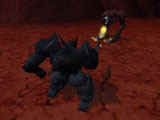 First, let’s get the obligatory comparison with MechWarrior 3 out of the
way. Apples and oranges. The games really aren’t very similar at all, and in fact if
I had to classify them generically, I’d say Mechwarrior 3 is a classic sim game, and
that Heavy Gear II is more of a first-person shooter. If you attempt the sort of tactics
in Heavy Gear II that work well in MechWarrior 3, you’re going to die. In Heavy Gear,
a premium is placed upon stealth and planning. Your gear will take a lot less damage than
a mech, and wading into combat with your guns blazing is a really bad move. You gear is
also a lot more mobile than a mech; it can run, skate, kneel, crawl, lie prone, and
maneuver in space. Mechs in MW3 tower over buildings and vehicles—the gears in HGII
run about 12-15 feet tall—still pretty big, but nowhere near the mammoth proportions
of, say, a 50-some foot Annihilator mech. First, let’s get the obligatory comparison with MechWarrior 3 out of the
way. Apples and oranges. The games really aren’t very similar at all, and in fact if
I had to classify them generically, I’d say Mechwarrior 3 is a classic sim game, and
that Heavy Gear II is more of a first-person shooter. If you attempt the sort of tactics
in Heavy Gear II that work well in MechWarrior 3, you’re going to die. In Heavy Gear,
a premium is placed upon stealth and planning. Your gear will take a lot less damage than
a mech, and wading into combat with your guns blazing is a really bad move. You gear is
also a lot more mobile than a mech; it can run, skate, kneel, crawl, lie prone, and
maneuver in space. Mechs in MW3 tower over buildings and vehicles—the gears in HGII
run about 12-15 feet tall—still pretty big, but nowhere near the mammoth proportions
of, say, a 50-some foot Annihilator mech.
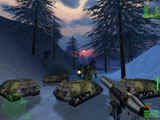 The game’s back story is that the armies of North and South Terra
Nova—at each other’s throats in the original Heavy Gear—have forged an
alliance against the irredeemable Earthers. You take command of an elite group of commando
gears, the Black Talon, and conduct a series of covert operations against your mutual
enemies. I’ve got to admit, the game’s campaign is far superior to MechWarrior
3’s—it’s got a pretty good narrative with some surprising twists, but
it’s also extremely varied. You’ll fight in a large variety of
settings—from frozen tundra to desert to space—and you’ll also be presented
with many different kinds of missions, from ambushes to pursuit to hit and run to
infiltration. Most of these missions are very well-crafted and exciting, but some of them
are a bit problematic. For example, while crawling painfully slowly during one
infiltration mission, I couldn’t help but wonder why any commander would send a
15-foot tall robot to sneak into anything. The game’s back story is that the armies of North and South Terra
Nova—at each other’s throats in the original Heavy Gear—have forged an
alliance against the irredeemable Earthers. You take command of an elite group of commando
gears, the Black Talon, and conduct a series of covert operations against your mutual
enemies. I’ve got to admit, the game’s campaign is far superior to MechWarrior
3’s—it’s got a pretty good narrative with some surprising twists, but
it’s also extremely varied. You’ll fight in a large variety of
settings—from frozen tundra to desert to space—and you’ll also be presented
with many different kinds of missions, from ambushes to pursuit to hit and run to
infiltration. Most of these missions are very well-crafted and exciting, but some of them
are a bit problematic. For example, while crawling painfully slowly during one
infiltration mission, I couldn’t help but wonder why any commander would send a
15-foot tall robot to sneak into anything.
The campaign can also be very difficult, especially if you bring a traditional mech mindset to the proceedings. And it’s not unusual to spend a half an hour of tortuous maneuvering during a mission, only to be fragged by the unexpected appearance of enemy units. Since there’s no in-game save feature, this means you get to start all over, and a mission that is initially fun and tense becomes more than a bit wearing after attempting it several times or so from the get-go. Man, could this game have used an in-game save feature—even though it’s not usual for mech games to have one, this is one place where Heavy Gear II could have taken an extra page from first-person shooters. One other odd thing about the campaign—though, as we shall see, the game offers a ton of choice and configuration options for your gear, you have to stick with the same gear type throughout the campaign. This seems an arbitrary choice, and one that can lead you to some problems during the campaign. Finally, the campaign is heavily scripted. Since the enemy AI is very good, this isn’t as annoying as it could have been, but a more dynamic campaign would have been nice. The game also features an excellent set of training scenarios, a very cool set of "historical" missions, and an Instant Action feature that’s marvellous—you get a slew of widely varied maps, and the ability to fight with and against customized forces. 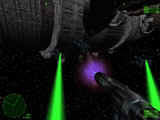 The game’s graphics are mostly very nice—they’re rendered with
Activision’s new Dark Side engine, and the terrain looks excellent. The engine
convincingly produces a wide variety of landscape effects--you’ll fight in snow,
towns, swamps, deserts, space, and the usual barren landscapes. Weather effects are also
nicely turned—storm effects, especially lightning and snow, are very atmospheric. But
the gears themselves are a bit of a disappointment, nowhere near as sharp as MW3’s
mechs. They actually look a lot more like Shogo’s mechs than MW3’s, except they
seem a little chubby, like middle-aged giant bots who have let themselves go a bit. And
weapons effects, though serviceable, aren’t as colorful or explosive as the
landscape. The game’s graphics are mostly very nice—they’re rendered with
Activision’s new Dark Side engine, and the terrain looks excellent. The engine
convincingly produces a wide variety of landscape effects--you’ll fight in snow,
towns, swamps, deserts, space, and the usual barren landscapes. Weather effects are also
nicely turned—storm effects, especially lightning and snow, are very atmospheric. But
the gears themselves are a bit of a disappointment, nowhere near as sharp as MW3’s
mechs. They actually look a lot more like Shogo’s mechs than MW3’s, except they
seem a little chubby, like middle-aged giant bots who have let themselves go a bit. And
weapons effects, though serviceable, aren’t as colorful or explosive as the
landscape.
You can also configure your gear in a lot of different ways; if you thought the mech lab in MW3 was extensive, wait until you see Heavy Gear II’s gear lab. Not only does each gear have several pre-configured models, but you can fuss with them endlessly, modifying not only the usual weapons, armor, ammo, but also its sensor, fire control, and maneuverability. And even nicer is the extensive list of perks and flaws you can add to the gear. Adding in flaws may seem like a strange idea, but since each gear is limited to a certain number of threat points per mission, you can sometimes reduce your overall threat points by building in a weakness in order to afford the high stealth rating you really need. 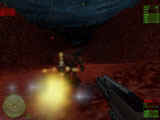 Once in the field, you’ll find the default control scheme to be
awkward—an abysmally configured keypad-and-mouse setup. This is especially dismaying
since the controls are difficult to reconfigure, and joystick support is spotty at best.
In the end, you’ll learn to use the defaults, and you may even become proficient at
them, but you won’t love them. You can, through dint of much labor, become pretty
good at controlling your gears, but it’s a much more difficult task than it should
have been. And oh yeah, control in the space missions is a bitch. Once in the field, you’ll find the default control scheme to be
awkward—an abysmally configured keypad-and-mouse setup. This is especially dismaying
since the controls are difficult to reconfigure, and joystick support is spotty at best.
In the end, you’ll learn to use the defaults, and you may even become proficient at
them, but you won’t love them. You can, through dint of much labor, become pretty
good at controlling your gears, but it’s a much more difficult task than it should
have been. And oh yeah, control in the space missions is a bitch.
You’ll eventually be given command of other gears. Again, there many options here, and your squad mates generally possess good AI, so you can actually put fairly sophisticated plans into effect. This task is made even easier by an easy-to-access real-time tactical map, to my mind one of the very best features of the game. You can use it to send gears on patrol, create waypoints, and coordinate timed attacks. The only downside to squad command interface is that it can be a pain to access in the game, especially in the heat of battle. And believe me, you’ll need to plan carefully, because the enemy AI is very sharp. In fact, I learned a lot about how to play this game by observing and copying the behavior of enemy forces, and I don’t think I’ve ever done that before. So Heavy Gear II is a strong combination of truly excellent features and a few awkward design decisions. I can see why so many of my friends and colleagues rave about it, but I still haven’t fallen in love with it. And I think it has to do with Heavy Gear’s gameplay, always the bottom line. It almost seems like Activision is trying to do too much here: to have a game that’s a mech and a first-person shooter, that encompasses both stealth and shoot’em up, that takes you from the swamps to space. That’s an admirable amount of variety, but for me it tends give the game a sort of indistinct feel—it just seems a little wishy-washy. On the other hand, this could just be a truly revolutionary game that I’m just too old and set in my ways to recognize as such. In either case, Heavy Gear II is so chock-full of goodness that I’m not gonna give up on it yet. Try it; you’ll probably like it. |